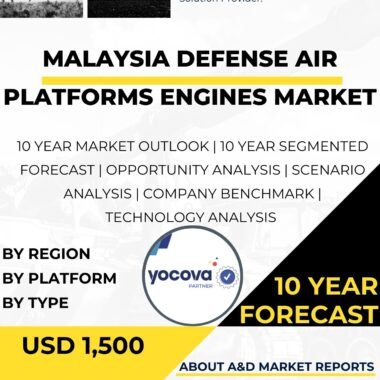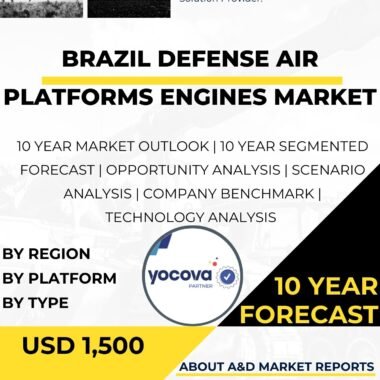Description
Singapore Defense Air Platforms Engines Market has witnessed steady growth in recent years, reflecting the nation’s continued commitment to strengthening its defense capabilities and maintaining a technologically advanced air force. Defense air platforms engines—propulsion systems that power military aircraft—are vital to ensuring aircraft performance, reliability, and mission success. This overview examines Singapore’s defense air platforms engines market, covering its key drivers, applications, challenges, and future prospects.
Singapore Defense Air Platforms Strategic Importance and Market Drivers
Singapore’s focus on defense modernization and operational readiness is a key factor driving growth in the air platforms engines market. As a small yet strategically positioned nation, Singapore prioritizes maintaining a capable and agile air force equipped with high-performance aircraft engines to ensure air superiority.
The adoption of advanced propulsion technologies enhances mission endurance, speed, and maneuverability, enabling Singapore to effectively safeguard its territorial integrity and deter regional threats.
Additionally, as a major defense player in Southeast Asia, Singapore faces complex security dynamics. Modern and efficient air platform engines enable rapid response and sustained air dominance, which are crucial for national security and regional stability.
Singapore Defense Air Platforms Domestic Industry Development and Global Collaboration
The growth of Singapore’s defense industry supports local participation in the development and production of advanced propulsion systems. Defense-related enterprises, including government-linked entities and private firms, engage in R&D, engine maintenance, and component manufacturing.
Collaboration with global defense companies has further strengthened Singapore’s access to state-of-the-art technologies. Through joint ventures, licensing agreements, and technology transfers, the country benefits from exposure to cutting-edge design, manufacturing techniques, and maintenance practices that enhance its indigenous defense ecosystem.
Applications in Military Aviation
Defense air platforms engines play a central role in powering the Republic of Singapore Air Force (RSAF) fleet, which includes fighter jets, transport aircraft, and helicopters.
Fighter Aircraft: Engines enable superior thrust-to-weight ratios, agility, and combat endurance.
Transport Aircraft: They ensure dependable performance in long-range and logistics missions.
Helicopters: Engines provide operational flexibility for both tactical and humanitarian missions.
Advanced propulsion systems help Singapore maintain operational readiness across diverse mission profiles—from air defense and reconnaissance to rapid deployment and training exercises.
Enhancing Air Defense and Interoperability
Modern engines directly contribute to Singapore’s air defense capabilities. They allow for rapid interception and response against potential threats, ensuring a robust aerial defense network.
Participation in joint military exercises with international allies—such as the U.S., Australia, and regional partners—further drives compatibility and standardization. These collaborations often involve aircraft sharing similar propulsion systems, reinforcing interoperability and joint operational effectiveness.
Challenges and Key Considerations
Despite its strong progress, the defense air platforms engines market in Singapore faces several challenges:
Technological Advancement Pressure: The fast pace of innovation in engine design demands continuous R&D investment to stay competitive.
Supply Chain Dependence: Singapore must manage both domestic production and imported components efficiently to ensure a steady, cost-effective supply of engines.
Lifecycle and Maintenance Costs: Sustaining advanced engines through their operational life requires specialized maintenance infrastructure and skilled personnel.
Strategic planning and long-term defense partnerships are essential to overcome these challenges and ensure operational resilience.
Future Prospects and Technological Trends
The outlook for Singapore’s defense air platforms engines market is highly positive. The government’s continued investment in defense modernization and emphasis on technological self-reliance will drive demand for advanced engine solutions.
Emerging innovations—including enhanced fuel efficiency, improved thrust-to-weight ratios, and advanced digital engine management systems—offer opportunities to boost performance, reduce operational costs, and enhance sustainability.
Future developments are expected to focus on integrating smart diagnostics, predictive maintenance, and next-generation propulsion technologies to support future air combat systems and unmanned aerial platforms.
Conclusion
The Singapore defense air platforms engines market forms a cornerstone of the nation’s airpower and defense modernization strategy. Advanced engines ensure that Singapore’s air force remains capable, reliable, and prepared for evolving security challenges.
While technological evolution and supply chain management present ongoing challenges, Singapore’s sustained investment, industrial collaboration, and strategic foresight continue to position it as a regional leader in defense aviation technology.
The market’s future remains bright—driven by innovation, international cooperation, and a firm national commitment to maintaining air superiority and operational excellence.




